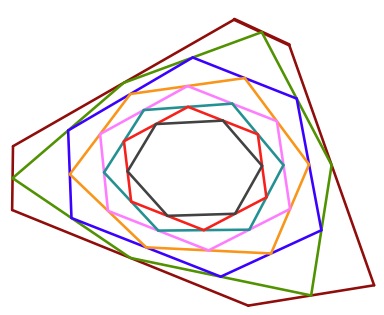Skip over navigation
 These pictures were made quite simply by starting with a square, finding the half-way point on each side and joining those points up. This creates a smaller shape (which also happens to be a square) inside the original. The half-way points of this new shape are then joined up to make a third shape. This way of making new shapes is continued until it gets too small to do properly.
These pictures were made quite simply by starting with a square, finding the half-way point on each side and joining those points up. This creates a smaller shape (which also happens to be a square) inside the original. The half-way points of this new shape are then joined up to make a third shape. This way of making new shapes is continued until it gets too small to do properly.
You can, of course, start with any straight-lined shape.
Here's one where I've coloured each new halving line to help to see what has happened more clearly.

So, it's your turn to have a go.
It's probably good to start with a fairly large shape since it's going to get smaller and smaller each time.
Some pupils may need to have help with the fine motor skills required whilst being interested in the overall effect of performing this kind of action on a shape.

Or search by topic
Number and algebra
Geometry and measure
Probability and statistics
Working mathematically
Advanced mathematics
For younger learners
Shaping It
Age 5 to 11
Challenge Level 





- Problem
- Getting Started
- Student Solutions
- Teachers' Resources
Shaping It

You can, of course, start with any straight-lined shape.
Here's one where I've coloured each new halving line to help to see what has happened more clearly.

So, it's your turn to have a go.
It's probably good to start with a fairly large shape since it's going to get smaller and smaller each time.
Here are some challenges for you to pursue:
- Having made a design like one above, cut out the triangles and the smallest inner shape and rearrange the pieces to form a new shape/design.
- Talk about and record the things you notice as you have drawn more and more halving lines.
- What is happening to the enclosed area each time the sides are halved? (Try investigating a regular shape first.)
This problem is based on an idea suggested by Ian Short.
Why do this problem?
This activity enables pupils with a wide range of attainment level to work on the same challenge to improve their concepts of shape and space. It also offers opportunities for further investigation and for pupils to create their own challenges.
Possible approach
This might need to vary according to your learners' experiences. For those who have good pencil, ruler and measuring skills, some of the examples here (Word document or pdf) could be presented. You could ask children to describe what they see, with a partner first and then open it out to the whole group. Discussion could follow that would allow pupils to decide what their own explorations would be. Some may want to create their own whereas those who struggle with motor control may wish to explore the
given ones.
It could be that you ask children to feed back about their discoveries orally, or you may wish them to create a poster of some kind. Encourage them to explain their observations. This activity could lend itself to being investigated over an extended period of time (a 'simmering activity') and it would be useful to dedicate a space on the wall for learners to contribute their work
during that time.
Key questions
What have you been exploring?
Tell me what you have found.
Possible extension
Some pupils may be encouraged to use a spreadsheet to explore sizes of different lengths/areas. Others may be encouraged to compare results when the new lines are placed a quarter (or other fraction) along the previous lines instead of half way.
Possible support
Some pupils may need to have help with the fine motor skills required whilst being interested in the overall effect of performing this kind of action on a shape.You may also like
Sports Equipment
If these balls are put on a line with each ball touching the one in front and the one behind, which arrangement makes the shortest line of balls?

